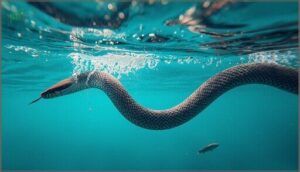This site is supported by our readers. We may earn a commission, at no cost to you, if you purchase through links.

You’re paddling across a lake when you spot a sleek shape gliding through the water—no legs, no fins, just pure sinuous motion. Snakes don’t just tolerate water; many species navigate it with astonishing grace, transforming their limbless bodies into efficient swimming machines.
The secret lies in lateral undulation, a wave-like movement that pushes water backward while propelling the snake forward. But there’s more to it than simple side-to-side motion. Body flexibility, muscle timing, and even subtle shape-shifting work together to create thrust and minimize drag.
Whether hunting prey in murky rivers or crossing open channels during migration, snakes have evolved extraordinary adaptations that turn a potential disadvantage into a survival asset.
Table Of Contents
- Key Takeaways
- How Do Snakes Swim?
- Snake Swimming Techniques Explained
- Adaptations for Aquatic Environments
- Factors Influencing Snake Swimming Ability
- Ecological Role of Snake Swimming
- Frequently Asked Questions (FAQs)
- How do snakes swim on water?
- Are snakes excellent swimmers?
- Why do snakes submerge in water?
- Do snakes sink or float?
- Can snakes swim in cold temperatures?
- How long can snakes stay underwater?
- Are snake bites possible while swimming?
- Do all snake species float while swimming?
- How do snakes avoid predators in water?
- Can all snake species actually swim underwater?
- Conclusion
Key Takeaways
- Snakes swim using lateral undulation—a wave-like motion that pushes water backward while propelling them forward, with muscle timing and body flexibility creating thrust while minimizing drag.
- Aquatic specialists have evolved paddle-shaped tails, laterally compressed bodies, and streamlined scales that boost swimming efficiency by up to 30% compared to terrestrial species.
- The myth that venomous snakes float while nonvenomous ones swim submerged is false—both groups use surface and submerged swimming depending on activity, not venom status.
- Swimming isn’t just locomotion for snakes; it’s essential for survival, enabling them to hunt prey, evade predators, migrate for reproduction, and access diverse aquatic ecosystems from coral reefs to mountain streams.
How Do Snakes Swim?
Snakes aren’t built like fish, yet they move through water with surprising grace and efficiency. Their swimming ability comes down to body mechanics, flexibility, and precise muscle control working together in fluid motion.
Let’s break down the core elements that make this possible.
Overview of Snake Swimming Mechanics
Snake swimming is a masterclass in fluid dynamics—each curve and ripple generates propulsion through careful energy transfer. You’re watching body undulation in action: waves that travel from head to tail, pushing against water while managing drag.
Here’s what powers aquatic maneuverability in these exceptional swimmers:
- Lateral undulation creates thrust by forming wave patterns that push water backward
- Vortex structures form along the body, stabilizing movement and boosting swimming energetics
- Muscle timing coordinates precisely, activating at peak body curvature to optimize forward motion
Every serpentine method movement in an aquatic environment relies on snake hydrodynamics—the same principles governing how all limbless reptiles navigate water with surprising efficiency. Understanding the snake swimming mechanics is essential for appreciating their aquatic abilities.
Role of Body Shape and Flexibility
What makes aquatic movement possible isn’t just technique—it’s the body itself. Body flexibility facilitates rapid shape-shifting from circular to laterally compressed cross-sections, boosting hydrodynamic efficiency mid-stroke. Musculoskeletal adaptations like shortened, powerful trunk muscles deliver elastic propulsion through water with minimal drag.
Unlike the serpentine method’s terrestrial glide or the concertina method’s anchored pushes, swimming demands constant deformation. Your typical snake’s ventral two-thirds can flex dramatically, storing energy that rebounds into forward thrust. The snake’s movement is facilitated by its elastic energy release mechanism, allowing it to propel itself efficiently.
Key Swimming Motions Used by Snakes
Flexibility shapes potential, but specific swimming techniques release performance. Lateral undulation dominates—about 95% of species rely on this serpentine method, generating waves that travel head to tail.
You’ll rarely see concertina swimming in open water; it’s reserved for tight spaces and burns 60% more energy. Sidewinding motion? Even rarer underwater, appearing in less than 3% of observations.
Aquatic propulsion hinges on wave mechanics, not brute force.
Snake Swimming Techniques Explained
When you watch a snake glide across water, you’re seeing an elegant biomechanical solution that’s been refined over millions of years. The way snakes propel themselves through water isn’t random—they rely on specific movement techniques that vary depending on whether they’re skimming the surface or maneuvering through deeper currents.
When you watch a snake glide across water, you’re seeing an elegant biomechanical solution refined over millions of years
Let’s break down the core swimming methods that make these creatures so naturally aquatic.
Lateral Undulation in Water
When you watch a snake glide through water, you’re seeing lateral undulation—the primary reptile locomotion technique that turns body waves into forward thrust. Muscle activity fires in precise sequences, pushing against the water’s resistance to generate hydrodynamic efficiency. Wave propagation moves faster than the snake itself, creating that signature weaving pattern.
Species variability means specialists perfect this aquatic adaptation while generalists adjust their swimming ability based on environmental interaction.
Comparison to Terrestrial Movement
On land versus in water, you’ll find five mechanical differences that reveal how snakes adapt their body flexibility and movement patterns to different worlds:
- Wave speed outpaces forward progress in water—but matches perfectly during terrestrial locomotion
- Body wave amplitude grows from head to tail when swimming, staying constant on land
- Energy efficiency jumps in aquatic environments, achieving greater displacement per undulatory cycle
- Muscle firing decouples from body bending during swimming—unlike terrestrial animals’ synchronized patterns
- Locomotor gaits diversify on land (concertina, sidewinding, rectilinear) while water favors smooth lateral undulation
These mechanical differences showcase reptile movement versatility across environments.
Surface Vs. Submerged Swimming
When you watch snakes navigate different water depths, you’re witnessing two distinct swimming strategies. Surface swimming helps them traverse long distances between breaths, exposed to predators but energy-efficient.
Submerged movement requires buoyancy control and specialized dive patterns—some sea snakes stay down eight hours using cutaneous respiration.
Hydrodynamic efficiency shifts with depth, as lateral body flattening and swimming abilities adapt to water resistance at each level.
Adaptations for Aquatic Environments
Not all snakes are built the same in terms of water. Some species have evolved striking physical traits that make them natural swimmers, while others stick to dry land.
Let’s look at the specific adaptations that separate aquatic specialists from their terrestrial cousins.
Physical Adaptations in Aquatic Snakes
Aquatic snakes have evolved striking physical features that boost their swimming prowess. Body flattening along the posterior half boosts hydrodynamic efficiency, reducing drag by compressing laterally during rapid movement. Tail morphology shifts dramatically—paddle-like shapes provide greater thrust. Scale reduction streamlines the body, while specialized sensory adaptations, like dome-shaped sensilla covering 6.5% of the body, improve navigation.
These aquatic adaptations showcase nature’s ingenuity in perfecting reptile locomotion and movement underwater.
Differences Between Sea, Freshwater, and Terrestrial Snakes
Sea snakes, freshwater snakes, and terrestrial snakes showcase radically different aquatic adaptations that reveal nature’s blueprint for survival. Sea snakes dominate with laterally compressed bodies and paddle-shaped tails, achieving swimming efficiency 30% higher than cylindrical terrestrial species.
Freshwater snakes compress only two-thirds of their trunk during rapid movement, while terrestrial snakes lack specialized aquatic locomotion features.
These distinct snake body plans directly shape habitat preferences, swimming efficiency, and species comparison across aquatic environments.
Tail and Scale Modifications for Swimming
You’ll find that tail morphology and scale structure represent nature’s most elegant solutions for aquatic adaptations in swimming performance. These reptile locomotion refinements transform clumsy land-dwellers into hydrodynamic efficiency masters:
- Paddle-shaped tails (35% tail length) boost swimming performance 25% through enhanced vortex generation
- Specialized scale modifications disrupt water boundary layers, reducing drag like shark skin
- Lateral tail compression facilitates propulsion rates of 1.6–3.2 km/h underwater
- Smoother, thinner scales enhance hydrodynamic efficiency in snake movement techniques
Factors Influencing Snake Swimming Ability
Not all snakes are created equal in terms of swimming prowess. Performance in water depends on a combination of species traits, the environment they’re traversing, and some persistent myths that blur the line between fact and fiction.
Let’s break down what really shapes a snake’s ability to move through aquatic habitats.
Species-Specific Swimming Performance
Not all snakes master the water equally—swimming speed and hydrodynamic efficiency vary dramatically across species. The yellow-bellied sea snake rockets forward at speeds reaching 1 meter per second, while freshwater water snakes cruise at a more modest 0.34 to 0.51 body lengths per second.
These differences stem from species variation in morphology, muscle distribution, and aquatic adaptation. Your underwater encounter depends entirely on which snake you’re watching.
Habitat and Environmental Impact
Where a snake lives shapes everything about how—and how well—it swims. Your underwater predator’s performance depends on prey availability, water temperature, channel width, and substrate smoothness. Climate shift and habitat loss are rewriting the rules: rising temperatures push sea snakes toward temperate waters, while freshwater species lose up to 73.6% of their range by 2080. Environmental degradation doesn’t just shrink snake habitats—it disrupts entire aquatic ecosystems.
Five critical habitat factors influencing snake swimming:
- Prey distribution – Abundant food keeps snakes in water longer, sharpening aquatic adaptation
- Water temperature – Warmer conditions alter diving behavior and metabolic rates
- Physical environment – Channel width and substrate type dictate swimming strategy
- Ecosystem balance – Healthy coral reefs and wetlands support specialized swimmers
- Species migration – Climate-driven range shifts force snakes into unfamiliar aquatic ecosystems
Myths About Venomous Vs. Non-Venomous Swimming
One viral myth refuses to die: venomous snakes float on top, nonvenomous snakes swim below. This species misconception drives public perception and puts water safety at risk. The truth? Both groups swim on the surface and submerged—cottonmouths dive for 30 minutes while hunting, and harmless water snakes cruise topside during migration. Swimming behavior reveals nothing about venom.
| Myth | Reality |
|---|---|
| Venomous snakes always float | Both venomous and nonvenomous species use surface and submerged swimming |
| Swimming style indicates danger | Posture depends on lung inflation and activity, not venom status |
| You can identify threats by watching them swim | Aquatic snake behavior varies by context—never rely on swimming techniques for identification |
Ecological Role of Snake Swimming
Swimming isn’t just a neat trick for snakes—it’s woven into their survival playbook. Whether they’re hunting prey beneath the surface, carving out territories across waterways, or managing the challenges of reproduction, their ability to move through water shapes how they live and thrive.
Let’s look at three key ways swimming defines their ecological role.
Aquatic Hunting and Feeding Behavior
When you picture an aquatic snake hunting, you’re witnessing masterful precision shaped by millions of years. These foraging behavior specialists employ diverse feeding strategies that reflect their unique niches within aquatic ecosystems. Here’s how aquatic snake behavior transforms them into effective predators:
- Prey detection happens through specialized mechanoreceptors sensing water vibrations
- Aquatic ambush tactics like the tentacled snake’s J-shaped strike position exploit fish escape responses
- Hunting success improves through suction feeding adaptations minimizing hydrodynamic drag
- Snake diet and prey varies dramatically—coral reef species target juvenile fish while freshwater snake species consume over 55,000 amphibians annually
- Snake swimming behavior synchronizes with seasonal patterns, intensifying during peak prey availability in summer months
Habitat Use and Range
Where these serpentine swimmers spend their time reveals astonishing ecological diversity. Understanding aquatic range and habitat preferences unlocks the geographic distribution patterns defining their ecological niche. About 14% of snake species utilize aquatic ecosystems—from tropical coral reefs to northern freshwater systems. Water snakes like Northern Water Snake occupy small home ranges (0.02–1.86 hectares), yet range dynamics vary widely among snake species based on prey availability and habitat structure.
| Habitat Type | Representative Species | Geographic Distribution |
|---|---|---|
| Marine/Coastal | Yellow-bellied Sea Snake | Indian & Pacific Oceans |
| Freshwater Rivers | Green Anaconda | South American wetlands |
| Lakes/Wetlands | Northern Water Snake | North American waterways |
| Ecotonal Zones | Common Water Snakes | Urban & rural interfaces |
| High Elevation Streams | Garter Snakes | Mountain aquatic systems |
Importance for Survival and Reproduction
Survival itself hinges on swimming prowess. The adaptation of snakes to aquatic environments directly shapes reproductive success and predator evasion throughout their lives. Sea snake neonates face 38 predatory attacks in just minutes—yet swimming abilities of snakes enable critical escape responses. Aquatic migration aids mate-finding across kilometers of open water, while gravid females maintain hydrodynamic efficiency through reduced clutch sizes.
Evolutionary adaptations in aquatic snake behavior reveal:
- Hunting mastery – Enhanced swimming speed translates to exceptional prey capture rates in rivers and reefs
- Genetic diversity – Long-distance dispersal through swimming promotes gene flow between isolated populations
- Offspring advantage – Marine snake neonates average 44% longer than terrestrial counterparts, improving immediate survival odds
Frequently Asked Questions (FAQs)
How do snakes swim on water?
When you spot a water moccasin gliding across a lake’s surface, it’s using lateral undulation—the same S-shaped wave patterns it employs on land.
Water resistance and snake buoyancy work together, creating hydrodynamic efficiency through rhythmic aquatic maneuvers.
Are snakes excellent swimmers?
Yes, snakes are excellent swimmers. All species display aquatic agility using lateral undulation, generating thrust against water resistance.
Sea snakes achieve impressive swimming speed—up to 5 mph—thanks to hydrodynamic efficiency and specialized paddle-shaped tails.
Why do snakes submerge in water?
Snakes submerge in water for aquatic escape from predators, thermal regulation in stable environments, and hunting opportunities where prey density increases.
Sea snakes also dive for hydration, drinking fresh rainwater that collects on the ocean’s surface.
Do snakes sink or float?
Whether a snake bobs at the surface or slips beneath depends on body composition, lipid reserves, and species-specific buoyancy control. Venomous water snakes usually float when stationary, while non-venomous species often sink below.
Can snakes swim in cold temperatures?
Cold water slows aquatic behavior markedly. While all snakes swim, temperatures below 15°C reduce their speed and stamina.
Most avoid water under 20°C entirely, seeking warmth instead to maintain thermal regulation and survival.
How long can snakes stay underwater?
Aquatic endurance varies dramatically by species. Most water snakes surface every 30 minutes during active swimming, while specialized sea snakes can remain submerged for hours—some exceeding eight hours through exceptional diving physiology and cutaneous respiration.
Are snake bites possible while swimming?
Yes, you can get bitten while swimming. Most aquatic snake bites happen when snakes feel threatened underwater. Venomous snakes like cottonmouths and sea snakes pose real water safety concerns, though fatalities remain rare.
Do all snake species float while swimming?
Not all snakes float while swimming. Sea snakes and aquatic species often float due to specialized buoyancy control and extended lungs, while many terrestrial snakes sink or swim submerged, depending on their morphology and adaptations.
How do snakes avoid predators in water?
When threatened, you’ll see them dart into dense vegetation or submerged structures, reducing predator encounters by up to 45%.
They also flatten their bodies for aquatic camouflage, release musk, and time movements with tides to avoid detection.
Can all snake species actually swim underwater?
Believe it or not, barely 11% of snake species have documented swimming abilities—and even fewer can navigate underwater with skill.
Sea snakes spend 97% submerged, while burrowing species rarely venture into aquatic evolution’s depths.
Conclusion
Like Proteus shifting form, snakes have mastered water through pure adaptive elegance. Understanding how snakes swim reveals nature’s blueprint for overcoming limitation—lateral waves, flexible spines, and specialized scales turning vulnerability into advantage.
Whether you’re watching a cottonmouth glide through southern swamps or a sea krait hunt Pacific reefs, you’re witnessing millions of years of evolutionary problem-solving. These limbless swimmers prove that constraint doesn’t mean defeat; it demands creativity.
- https://pubmed.ncbi.nlm.nih.gov/32271916/
- https://www.sciencedirect.com/science/article/abs/pii/S094420060700075X
- https://journals.biologists.com/jeb/article/226/13/jeb245929/323175/Measuring-the-3D-wake-of-swimming-snakes-Natrix
- https://www.guinnessworldrecords.com/world-records/93347-fastest-swimming-snake
- https://royalsocietypublishing.org/doi/10.1098/rsif.2022.0875












